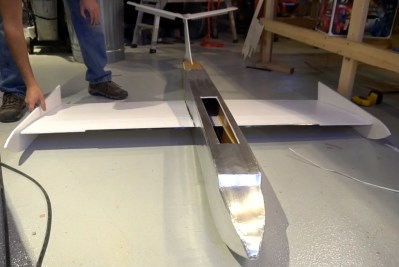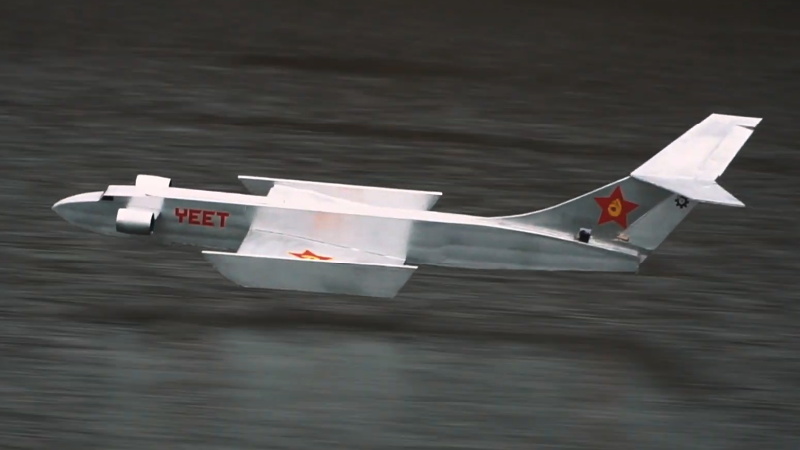In the 1960s the Soviet Union began experimenting with what they called ekranoplans, ground effect vehicles (GEVs) that were something of a hybrid between a ship and a large airplane. Their stubby wings didn’t provide enough lift for the vehicle to fly in the traditional sense, the craft essentially rode on a cushion of pressurized air produced by the aerodynamic interaction between the wings and the surface of the water. But after decades of testing, the ekranoplan never became much more than a curiosity for American intelligence agencies to ponder over.
Now [Peter Sripol] has built his own version of what the CIA dubbed the “Caspian Sea Monster”, and judging by the video of him “flying” it around a lake, the design seems to tick all the boxes. The advantage of a GEV is that it’s far faster than a ship and more fuel efficient than an aircraft of similar size. They also operate low enough to avoid enemy radar, which made them very appealing for military applications. Not that any of those characteristics apply to an RC vehicle, but at least it looks cool.
 Ironically, it took some extra effort for [Peter] to keep his scratch built ekranoplan from getting airborne. Built out of foam covered with aluminum tape, the craft was light enough that even the tiny wings were enough to break it free from the ground effect if it got going fast enough. It didn’t help that the electric ducted fan motors used were probably a bit too powerful as well.
Ironically, it took some extra effort for [Peter] to keep his scratch built ekranoplan from getting airborne. Built out of foam covered with aluminum tape, the craft was light enough that even the tiny wings were enough to break it free from the ground effect if it got going fast enough. It didn’t help that the electric ducted fan motors used were probably a bit too powerful as well.
But by carefully adjusting the throttle and control surfaces, [Peter] was able to keep his craft firmly planted in the ground effect most of the time. Seeing the large RC craft floating just a few inches over the water is very impressive, and thanks to the application of some Soviet-style iconography on its burnished aluminum body, it looks like found-footage from a Cold War test program.
Hackaday readers will likely be familiar with [Peter] and his exploits. From building his own human-scale airplane out of foam board to convincing a cordless drill that it can fly, he’s creations have never been overly concerned with the status quo.
















“Built out of foam covered with aluminum tape”
great idea
I have highly sticky alu tape, I can donate to some smart projects.
“Ground Effect Vehicle Skims Over The Water”
is an old idea, successfully replaced by modern hydrofoils, featuring improved stability
Just enter “hydrofoil” into your preferred search engine and switch to image or video mode
Googling hydrofoil and Ground effect led me to a video explaining why they were better than hydrofoils. https://www.youtube.com/watch?v=yVdH_dYlVB8
“In the 1950s, the fastest boats in the world were hydrofoils. A type of boat
with wings attached to its hull. And they were an ingenious innovation. Because at
speed, the wings would lift the boat out of the water to reduce drag. Allowing for
much higher speeds. But even the fastest hydrofoils could reach no more than
110 km/h. Held back by a phenomenon known as cavitation,
which disturbed the lift generated by a hydrofoil’s wings. It was a problem that
engineers would never solve. But a pioneering Soviet hydrofoil designer by
the name of Rostislav Alexeyev had a radical idea. What if he moved the wings
out of the water entirely? Doing so would mean a shift from hydrodynamics to
aerodynamics. But it would allow for previously unimaginable speeds. Once
Alexeyev’s ships were moving fast enough, they would lift right out of the water.
But they wouldn’t fly like aircraft. Instead, they’d ride on a cushion of air
just above the surface. Pilots had long noticed when landing or flying very
close to the ground, their planes would seem to gain extra lift. Almost as if
they didn’t want to land. This phenomenon was the ground effect.”
But the problem with ground effect planes is the ridiculous power needed to start them up. So what about a ekranoplan that starts as a hydrofoil and when it gets to 110km/h it retracts the hydrofoil and becomes a ground effect plane?
That is a real thing which existed. However the additional weight and complexity of retractable hydrofoils was not helpful compared to what was called PAR. Power augmented ram. In this video peter puts the engines on the front but doesn’t point them under the wing which was one way of getting ground effect going sooner. If you look at a more successful ekranoplan you can see the nose mounted engines are all ducted to exhaust towards the underside of the wing to lower the critical speed required for takeoff. https://en.wikipedia.org/wiki/A-90_Orlyonok
Hydrofoils don’t leave the water, the foils are _underwater_ wings.
The ekranoplan uses ground effect, and is therefore more like a skirtless hovercraft.
Once the downward trim got dialed in, it looked surprisingly realistic on the water, which isn’t always the case for scaled down models. This was a thoroughly entertaining video.
alu tape makes wonders
Yeet!
“They also operate low enough to avoid enemy radar, which made them very appealing for military applications. Not that any of those characteristics apply to an RC vehicle, but at least it looks cool.”
You’ll never know what skills you’ll need in overthrowing a bad government.
We’ll bolt two airboats together upside down, use fishing kayaks for wingtips, power it with one motor and come over the swamps at dawn.
That’s just damn cool.
Ive still got plans for this, with props for the front drive and those servo operated to help with grass takeoff. I planned on trying to set that with a gyro for active stabilization to avoid blowovers. but 10 years ago gyros weren’t cheap enough to consider. now with brushless motors, gyros and 3 channel pistol grip radios cheap, might revisit it. http://www.grahamktaylor.com/models1/ekranoplan1/whizzywig_section/whizzywig_plans.html
The phenomenon of ground effect is caused by the disruption of the vortex wakes from the wing tips, not the pressure of air under the wing –which would be there in either case.
Flying in ground effect has the potential of carrying larger payloads and with better fuel efficiency than if one were to attempt flying at high altitude. Unfortunately, it is a fair-weather craft. Once you get more than one wing length above the water, drag from the wing tip vortices will increase. So if there are large swells at sea, this is not an appropriate vehicle.
That, or you need a ground effect plane with a larger wingspan. Like a Pelican: https://en.wikipedia.org/wiki/Boeing_Pelican , which would have had a wingspan of some 500 feet, which should be long enough to avoid even the largest of waves.
This was one of the best GE model flights I seen and I’ve been studying GE for 8 years.
GE only exist in very thin layer above the surface. While Drag reduction (compared to free stream) can exist up to a couple of spans in elevation, most GE lift enhancement (over free stream lift) exists at elevations less than 10% of chord. It looked as if you caught some at a few point in the flight.
The part of the flight over the boat was well outside of GE but…
The part of the flight beside the boat was very stable by GE standards.
Congratulations.
How did you protect the motors from the water?